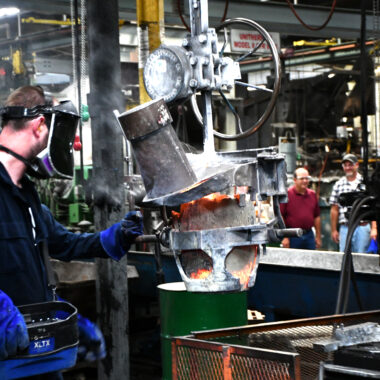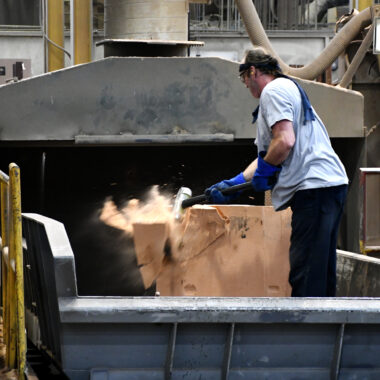Aluminum Casting Demystified: Secret Techniques for Success
Aluminum Casting Demystified: Secret Techniques for Success
Blog Article
Study the World of Aluminum Casting: Understanding the Different Approaches
Light weight aluminum casting is an essential procedure in the production market, with various techniques employed to develop complex and exact parts. Comprehending the different strategies utilized in aluminum spreading can give useful insights right into the abilities and constraints of each method. From the standard sand spreading technique to the advanced die spreading process, each method uses distinct benefits depending upon the requirements of the project. Checking out these diverse methods can use an extensive view of the opportunities within the world of aluminum spreading and just how each strategy adds to forming the modern-day production landscape.
Sand Casting Technique
Sand spreading, a widely-used technique in aluminum casting procedures, entails developing molds made from compressed sand for pouring molten metal. This technique is very flexible and economical, making it a prominent option for various markets. The procedure starts with the production of a pattern, generally made of wood or metal, which is then pressed into the sand to leave a perception. The sand mixture, normally silica sand combined with a binder like clay, is snugly loaded around the pattern to create a mold and mildew tooth cavity. When the mold and mildew prepares, it is firmly placed in a flask and molten aluminum is put right into the cavity.
After the metal has actually cooled down and strengthened, the sand mold and mildew is escaped to disclose the light weight aluminum spreading. Sand casting permits the production of intricate forms and big parts that may be expensive or difficult to create making use of various other methods. It is also a lasting method as the sand can be recycled and made use of multiple times, lowering waste in the spreading process.
Permanent Mold And Mildew Method

One significant advantage of the Permanent Mold And Mildew Strategy is the enhanced dimensional accuracy it provides. The metal mold enables tighter tolerances and finer information in the last light weight aluminum spreadings compared to sand casting techniques. This accuracy makes it a favored option for applications where tight dimensional control is important, such as in the aerospace and automotive markets.

Pass Away Casting Refine

Investment Casting Method
Utilizing a precision spreading approach, Financial investment Casting Technique entails developing complex light weight aluminum elements by pouring molten steel right into a ceramic mold. This process, additionally referred to as lost-wax casting, begins with the creation of a wax pattern of the desired part. This wax pattern is then covered with a ceramic material to develop a shell. As soon as the ceramic covering is hardened, it is warmed to remove the wax, leaving a hollow ceramic mold and mildew.
Investment spreading is frequently used for producing parts in industries where complex layouts and limited tolerances are called for, such as aerospace, automotive, and clinical devices. The convenience and accuracy of the Investment Casting Method make it a useful strategy in the globe of aluminum casting.
Lost Foam Casting Technique
Having actually discovered the detailed precision of Investment Casting Method, the focus now moves to the cutting-edge approach of Lost Foam Spreading in light weight aluminum part production. Lost Foam Spreading, additionally referred to as evaporative pattern spreading, is a modern method where a foam pattern of the preferred component is produced and after that coated with a refractory material. The covered foam pattern is after that hidden in sand, and molten light weight aluminum is put right into the mold and mildew. As the metal fills up the mold and mildew, the foam vaporizes as a result of the warmth, leaving a tidy tooth cavity in the shape of the wanted component.
In Addition, Lost Foam Casting is a cost-effective procedure as it decreases the need for cores and allows for the production of lightweight parts. In spite of its advantages, Lost Foam Casting calls for careful control of the spreading news process to guarantee and protect against problems top quality elements.
Verdict
In verdict, aluminum spreading supplies a variety of approaches such as sand casting, long-term mold and mildew strategy, die casting, financial investment casting, and shed foam spreading. Each approach has its own advantages and applications, making light weight aluminum casting a functional and commonly utilized procedure in numerous industries. Comprehending the distinctions in between these techniques is important in picking one of the most suitable casting technique for certain production requirements.
Sand spreading, a widely-used method in aluminum casting processes, entails producing mold and mildews made of compressed sand for putting liquified steel. aluminum casting.The Irreversible Mold Strategy, like sand spreading, is another prevalent method employed in light weight aluminum spreading procedures, supplying distinctive benefits in terms of mold and mildew reusability and dimensional precision. The metal mold allows for tighter resistances and better information in the last light weight aluminum spreadings contrasted to sand casting methods. The two primary types of die casting are cold chamber die casting and warm chamber pass away spreading, each appropriate for different types of light weight aluminum alloys.In final thought, aluminum casting offers a variety of approaches such as sand spreading, permanent mold and mildew strategy, pass away casting, investment spreading, and shed foam spreading
Report this page